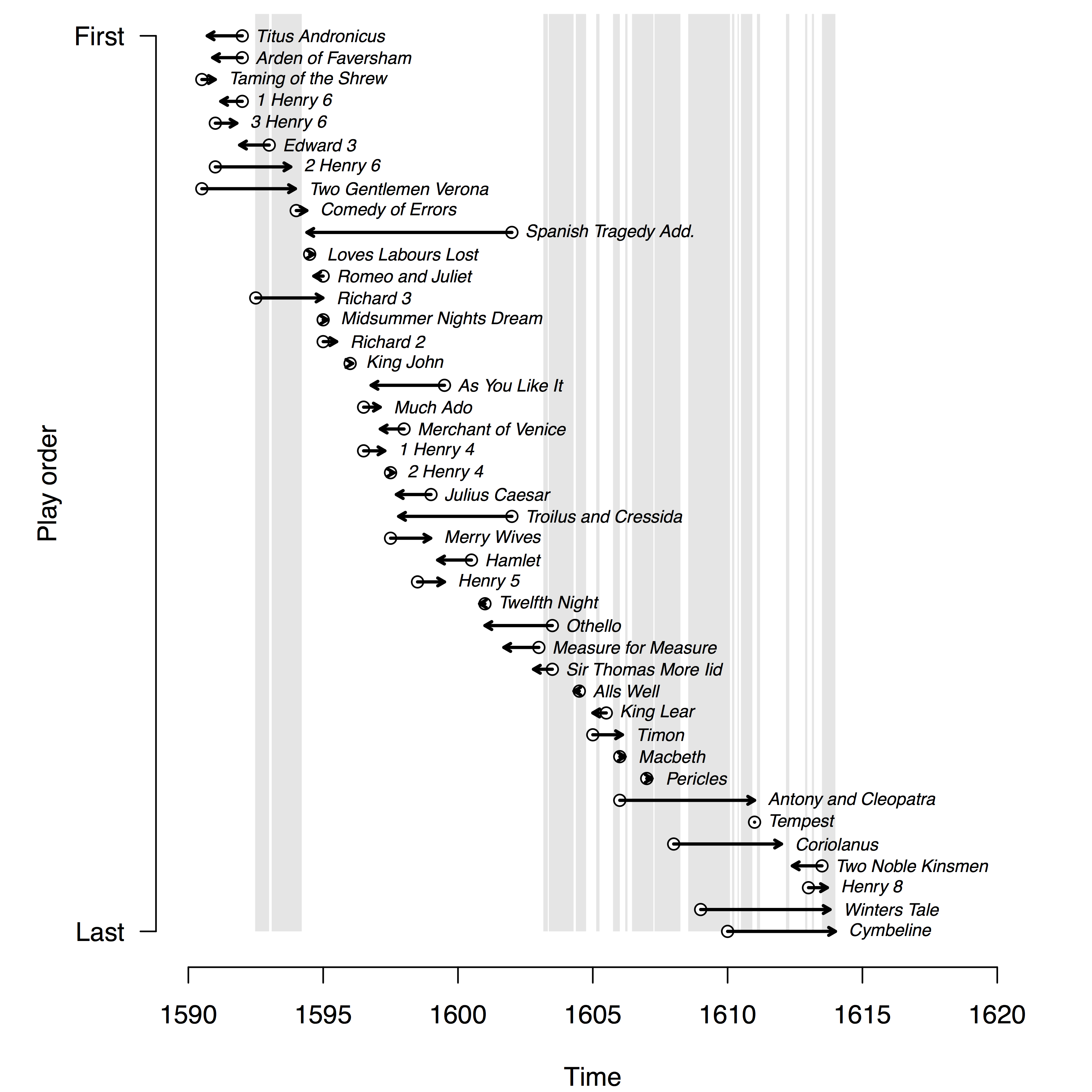Geneviève K. Smith
Scientist, team builder, startup advisor Former VP Product at Insight Data Science She / her, how to pronounce my name
bio | projects
linkedin | twitter | github | medium

Cryptic Species Coexistence | Damselfly Wing Morphometrics
Dating Shakespeare | Flu Visualization | Forest Resilience
Building a New Timeline for Shakespeare’s Plays.
Bruster, D.S., and G.K. Smith. A New Chronology for Shakespeare's plays. Digital Scholarship in the Humanities (formerly Literary & Linguistic Computing ), Volume 31, Issue 2, June 2016, Pages 301–320, https://doi.org/10.1093/llc/fqu068.
Within the 10-syllable structure of the iambic pentameter there may be pauses, either commas, colons, semi-colons, or perhaps a full stop, followed by another character picking up where the first left off. For example, in the following lines from Two Gentlemen of Verona:
Cease to perswade, my louing Protheus;
Home-keeping-youth, haue euer homely wits,
There is a comma after the 4th syllable in both the first line and in the second (not counting those at the 10th position). Whereas the text below, from The Tempest, all the pauses come later within each line.
Had I byn any God of power, I would
Haue suncke the Sea within the Earth, or ere
It should the good Ship so haue swallow'd, and
The fraughting Soules within her.
Interestingly, the relative positions of these pauses are not random throughout the text of Shakespeare’s plays. Instead, they tend to most often occur after the 4th and 6th syllables. And furthermore, the proportion of pauses in each position changes across the plays as Shakespeare’s style evolved over time. Although we have a good idea ofwhen Shakespeare lived and worked, we actually don’t know the exact dates of when each of his plays were written. Using the pause patterns to group plays with similar structure, we can put the plays in order. Remarkably, this ordering fits very well with previously-known dates, and in the cases where we see divergence there is perhaps a case to be made for a revision.
Heatmap illustrating the proportional abundance of each pause type (1st through 9th position along each row) for all of Shakespeare's plays. Plays are ordered according to Oxford's Textual Companion (1987).
The proportion of pauses at each position (after the first syllable, after the second, and so on) changes throughout Shakespeare’s plays. Plays are ordered according to the standard chronology scholars generally agree upon. Notice how he uses mostly 4th-position pauses in his early plays; for example, look at plays like Taming of the Shrew (SHR), Henry VI, part III (3H6), or Love's Labour Lost (LLL). In the middle part of his carrer, we see plays like Hamlet (HAM) and Othello (OTH) where there are two distinct peaks at the 4th and 6th position. By the time we reach his latest plays, including Henry VIII and Two Noble Kinsmen, there is a clear shift to more 6th-position pauses.
For each play we have plotted the relative abundance of each pause type. Plays are ordered chronologically in columns.
We can summarize most of the variation across plays by recasting the raw data using Correspondence Analysis (which is similar to the more-familiar Principal Components Analysis, but more appropriate for count data). Using a version of this approach (called Constrained Correspondence Analysis) we can generate a timeline based on the pause count data.

Plays are ordered from top to bottom according to our revised timeline. For each play an empty circle indicates the currently-accepted, standard (e.g. Oxford et al.) date. The arrows show how our proposed dates differ, either earlier or later, with the arrowheads positioned at our proposed dates. The grey shading shows time periods when the playhouses were closed due to plague.
Our new proposed timeline agrees well with the accepted dates for many plays, but in some cases there are discrepancies.